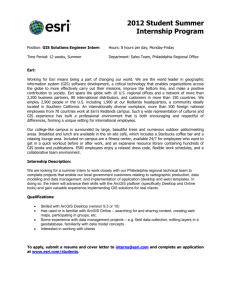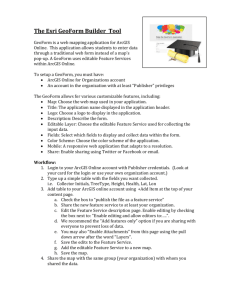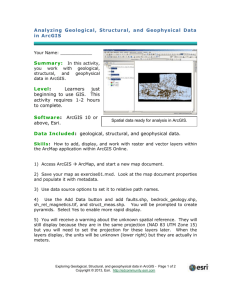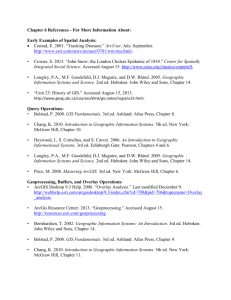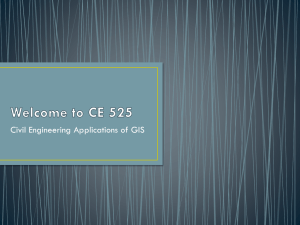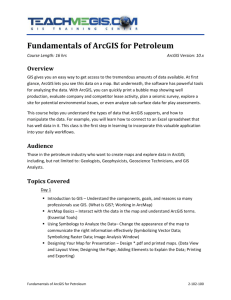Document
advertisement
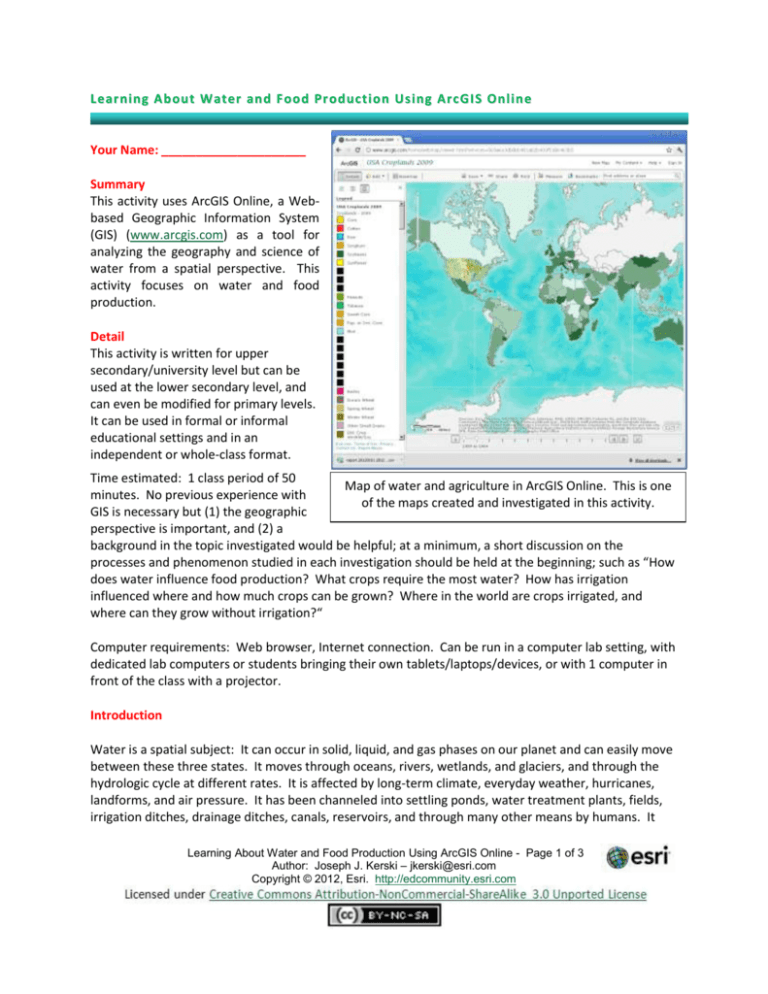
Learning About Water and Food Production Using ArcGIS Online Your Name: _____________________ Summary This activity uses ArcGIS Online, a Webbased Geographic Information System (GIS) (www.arcgis.com) as a tool for analyzing the geography and science of water from a spatial perspective. This activity focuses on water and food production. Detail This activity is written for upper secondary/university level but can be used at the lower secondary level, and can even be modified for primary levels. It can be used in formal or informal educational settings and in an independent or whole-class format. Time estimated: 1 class period of 50 Map of water and agriculture in ArcGIS Online. This is one minutes. No previous experience with of the maps created and investigated in this activity. GIS is necessary but (1) the geographic perspective is important, and (2) a background in the topic investigated would be helpful; at a minimum, a short discussion on the processes and phenomenon studied in each investigation should be held at the beginning; such as “How does water influence food production? What crops require the most water? How has irrigation influenced where and how much crops can be grown? Where in the world are crops irrigated, and where can they grow without irrigation?“ Computer requirements: Web browser, Internet connection. Can be run in a computer lab setting, with dedicated lab computers or students bringing their own tablets/laptops/devices, or with 1 computer in front of the class with a projector. Introduction Water is a spatial subject: It can occur in solid, liquid, and gas phases on our planet and can easily move between these three states. It moves through oceans, rivers, wetlands, and glaciers, and through the hydrologic cycle at different rates. It is affected by long-term climate, everyday weather, hurricanes, landforms, and air pressure. It has been channeled into settling ponds, water treatment plants, fields, irrigation ditches, drainage ditches, canals, reservoirs, and through many other means by humans. It Learning About Water and Food Production Using ArcGIS Online - Page 1 of 3 Author: Joseph J. Kerski – jkerski@esri.com Copyright © 2012, Esri. http://edcommunity.esri.com acts as a change agent above, on, and below the surface of the Earth, affecting such phenomena as crop yields, aquifers, erosion, floods, stream sediment, soil chemistry, weathering, and much more. It operates on a scale from local to global. Because water exists, moves, and acts at different scales and affects so many other phenomena, the geographic perspective is critical to understanding it. And, GIS is a very useful tool in which to study water in all of its forms, processes, and aspects. Watch the movie “geographic reflections on water”: http://youtu.be/ntJvY4LixqQ Name 3 connections between water and geography. Because of these and a whole host of other factors, the geographic perspective is critical to understanding water. GIS allows the geographic perspective to be applied to the study of water, and ArcGIS Online provides a toolkit and rich set of data that allows you to study water right away. ArcGIS Online Investigation This investigation uses ArcGIS Online, on http://www.arcgis.com. Investigating Water and Food Production Examine the resources on the World Water Day site: http://www.unwater.org/worldwaterday/ Look at the FAQ section and name three reasons why the linkages between water and food production are important. At ArcGIS Online (www.arcgis.com), click on “map.” Using the search box, find the map “USA Croplands 2009”. Open this map in ArcGIS Online. In ArcGIS Online, examine the legend for this map layer. What does this layer show? Describe the pattern of cropland in the USA, naming at least 3 crops and where they are grown. Name at least 3 reasons why these crops are grown where they are. Name three regions of the USA where irrigation is required to grow crops. What implications does irrigation have on the local and regional aquifers? What implications does irrigation and subsequent crop growth have on the local economy, employment, and settlement? What implications does irrigation and subsequent crop growth have on the international food market? Zoom out to the world. Turn off USA croplands and Add the layer “World Bank Agriculture and Rural Development” by the Intl_User_Community. Expand the layer to reveal the layers underneath. Turn Learning About Water and Food Production Using ArcGIS Online - Page 2 of 3 Author: Joseph J. Kerski – jkerski@esri.com Copyright © 2012, Esri. http://edcommunity.esri.com on the “Percent land used for Agricultural.” Describe the pattern. Name three factors that influence how much land in a country is used for agriculture. Enable the popup for this layer. Can you find any countries where over 67% of the land is used for agriculture? Do some research on the relative amount of water needed for agriculture versus other land uses. What implications does water quantity and quality have on crop production now, and in the future? Turn off the “Percent land used for Agricultural” layer and turn on the “Percent Arable Land” layer. Describe the pattern. Name three factors that influence the percent arable land in a country or region. How does irrigation change the area, amount, and type of crops that can be grown across the world? In your view, is widespread irrigation of crops sustainable? Why or why not? Do you agree or disagree with the following statement: Water is a renewable resource. Turn off this layer and turn on the “Crop production index”. Note that this data layer is time enabled, with the time slider bar below the map. Describe how productivity has changed in the following three countries: India, China, and the USA. Select another country of your own choosing and describe productivity there. What affect does global population increase have on the demand for food and for water? Synthesis Name three things you have learned about water and food production through any of the above investigations. Name three things you have learned about GIS through these investigations. How has the spatial perspective about water and food production influenced your understanding of this relationship? If time permits, use the presentation mode in ArcGIS Explorer Online to create a presentation of your own choosing where you explain what you have learned about a specific aspect about water and food production. Give your presentation to your peers, save it, and share it with others. Additional Explorations You have explored a few aspects of water and food production from a spatial perspective, but much more could be done. Write your own question about water and food production, investigate it, and answer it! Learning About Water and Food Production Using ArcGIS Online - Page 3 of 3 Author: Joseph J. Kerski – jkerski@esri.com Copyright © 2012, Esri. http://edcommunity.esri.com
